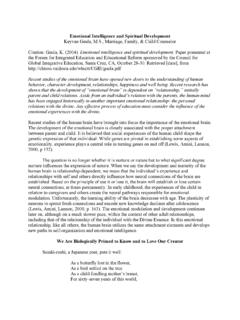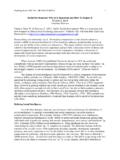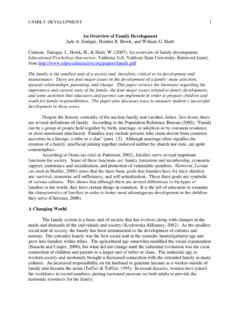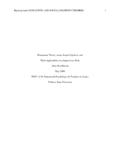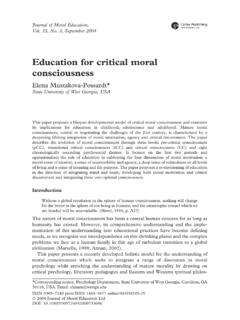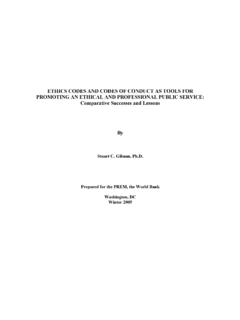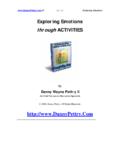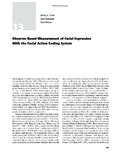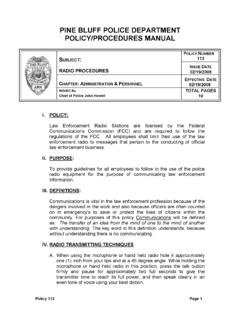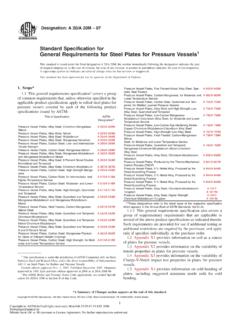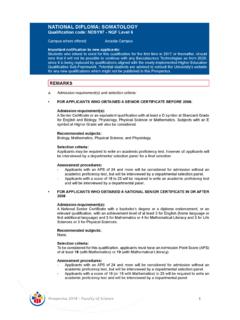Transcription of A Holistic View of Education and Schooling: …
1 Holistic view 1 A Holistic view of Education and schooling : guiding students to Develop Capacities, Acquire Virtues, and Provide Service William Huitt Citation: Huitt, W. (2011, July). A Holistic view of Education and schooling : guiding students to develop capacities, acquire virtues, and provide service. Revision of paper presented at the 12th Annual International Conference sponsored by the Athens Institute for Education and Research (ATINER), May 24-27, Athens, Greece. Retrieved from This paper considers the development of the whole person from the perspective of developing capacities in nine domains: (1) temperament, personality, and self-views, (2) cognition/thinking, (3) affect/emotion, (4) conation/volition (or self-regulation), (5) physical/bodily-kinesthetic, (6) social/interpersonal; (7) spiritual/ transpersonal, (8) moral character, and (9) citizenship. Basic research is considered as well as how interested adults, especially educators, can facilitate development in these areas.
2 Parents, educators, and concerned citizens around the world are asking questions about how best to prepare children and youth for successful adulthood in the twenty-first century. The question takes on added importance because humanity is immersed in a social and cultural environment that is changing at an accelerating rate (Kurzwiel, 2001). Simultaneously, there is exponential growth in an understanding of human capacities and the potential for human development (Damon, 2004). Though every human society has dealt with issues of preparing children and youth for adulthood, the potential benefits have never been greater for providing the proper learning experiences so that young people can flourish as adults. While it is acknowledged that schools are not the only social institutions responsible for the Education of children and youth (Huitt, 2009a), schools are where most will engage in formal, systematic learning experiences rather than the informal and sometimes conflicting learning experiences provided by the home, community, and larger society (Wikeley, Bullock, Muschamp, & Ridge, 2007).
3 Focusing on schools as a means for preparing young people for adulthood is one of the hallmarks of developed countries (The National Commission on Excellence in Education , 1983). On the other hand, when positive connections are made between home, school, and community, the impact can be even more powerful (Epstein, & Sanders, 2000; Henderson, & Mapp, 2002; Roehlkepartain, Benson, & Sesma, 2003). A new vision for educating children and youth, both formally and informally, is required if they are to become successful adults in the twenty-first century. Exactly what that means needs to be considered and plans need to be made and implemented (The Partnership for 21st Century Skills, 2009; Tate, 2008). This requires the ability to think beyond the actual to the possible through the use of imagination. Liu and Noppe-Brandon (2009) make an excellent point that the use of imagination is the first step towards developing creative solutions to seemingly intractable challenges.
4 It is then necessary to develop innovative products and services that can be used to meet those challenges. The purpose of this paper is to provide an overview of research describing innate capacities of human beings that can be actualized through directed school-based experiences and to review the types of curricula, learning experiences, and potential accountability procedures that educators can use to do so. This information is also important to parents and community members who want to facilitate development of a broad range of knowledge, attitudes, and skills Holistic view 2 related to successful development (Bushaw, & Gallup, 2008; Elam, Rose, & Gallup, 1992; Gallup, 1975.) It is intended that readers will be stimulated to provide more of the types of experiences that will allow children and youth to prepare for the challenging times they will face as adults. Identifying Capacities The first step in the identification of potential capacities that could be developed via guided learning experiences is to investigate human capacities considered to be intelligences as these refer to an ability or aptitude for learning.
5 A second step is then to investigate whether available research showed that the movement from capacity to competence ( , an actualized capacity) could be facilitated through guided learning experiences. A third step is then to investigate the most likely contexts within which individuals will use those capacities. Perhaps the most widely accepted approach to identifying a variety of human capacities is Gardner s (1983, 2006) work on multiple intelligences. He initially identified seven intelligences. Three of the intelligences have been labeled Symbol Analytic in that they involve making a conversion from a symbol to a higher-level mental code ( , linguistic translating letters and words into knowledge and concepts; logical-mathematical converting numbers to quantitative concepts and to think rationally and/or logically; musical translating written musical symbols in timbre, pitch, and rhythm). Two of Gardner s intelligences are considered Personal intelligences in that they are oriented to the person (intrapersonal knowledge of one s self and interpersonal knowledge of others, especially their moods and motivations).
6 Finally, two additional intelligences might be considered as Object-oriented intelligences (spatial the ability to mentally rotate an object in space and bodily-kinesthetic the ability to control one s body and handle objects skillfully). Gardner (1999) later identified an eighth intelligence which he labeled naturalist (an Object-oriented intelligence). He defined this as an ability to discern differences in one s natural surroundings. A ninth intelligence, labeled existential (a Transpersonal intelligence) is still under consideration. It involves that ability to search for and connect with universal unknowns. In the process of investigating other research that might confirm the concept of multiple intelligences, eight domains were identified separately by a variety of researchers: (1) temperament, personality, and self-views, (2) cognition/thinking, (3) affect/emotion, (4) conation/volition (or self-regulation), (5) physical/bodily-kinesthetic, (6) social/interpersonal; (7) spiritual/ transpersonal, and (8) moral character.
7 Interestingly, five of these relate to terms used by the ancient Greeks to describe different aspects of a human being: body (bodily-kinesthetic), mind (cognition/thinking, affect/emotion, and conation/volition), and soul/spirit. Research also identified human capacities for social interaction, morality, and the creation of self-views. A ninth dimension, citizenship, was added as that is the role within which these capacities will be used. There is considerable overlap between Gardner s (1999, 2006) list of multiple intelligences and the list of intelligences identified separately by others whose research will be discussed below. For example, both lists contain bodily-kinesthetic, social/interpersonal, existential/spiritual, and self/intrapersonal. The domain of cognition/thinking is represented in Gardner s work as a combination of linguistic and logical-mathematical intelligences. However, Gardner does not identify intelligences linked with the domains of affective/emotion, Holistic view 3 volition/conation, and morality.
8 Likewise, spatial, musical, and naturalistic intelligences are not considered as intelligences by other researchers. The domains might be considered as points on a star with the self and self-views central to the image and the concept of local-global-cosmic citizenship used as the amalgamation of the adult roles in which individuals engage in the modern world (see Figure 1). This is a revision of the Becoming a Brilliant Star framework previously developed (Huitt, 2006a). It shows that the domains are developed within a multi-level sociocultural context where family, school, religious organizations, and friends, as well as the connections among them, provide the most direct influence on one s development, but that development is also influenced by larger social and cultural forces. Figure 1. Becoming a Brilliant Star Framework Holistic view 4 The remainder of this section will briefly review capacities represented by the eight intelligences.
9 Discussed first are different ideas regarding the development of the knowledge of one s self or intrapersonal intelligence will be considered. This is followed by a discussion of cognition and thinking, as that is the dominant domain used for identifying the capacity to do well in school through developing academic competence. Next considered are the other two faculties of the mind, affect or emotion and conation or volition (currently discussed primarily in research on self-regulation). The domains of physical or bodily-kinesthetic intelligence, social intelligence, spiritual intelligence, and moral intelligence will then be discussed. Self and Self-Views (Intrapersonal Intelligence) Many researchers have demonstrated that the concepts of self and self-views are essential to the study of human behavior. Probably the most fundamental concept is that of temperament, considered an innate or inherited aspect of personality (Derryberry, & Reed, 1994; Keirsey, 1998).
10 For example, one s levels of excitability or irritability are considered aspects of one s temperament as well as one s tendency to introversion or extroversion. Temperament has been shown to be related to learning style (Oakland, & Joyce, 2004), development of competence and motivation (Rothbart, & Hwang, 2005), the type of career one prefers while a student (Oakland, Stafford, Horton, and Glutting, 2001), and the type of career one selects as an adult (Keirsey). Personality is another way of conceptualizing how an individual organizes one s thinking, feeling, intending, and behavior. The most widely used description in modern psychology is the 5-Factor model (McCrae, & Costa, 1997). The five factors (making the acronym, OCEAN) are (1) openness (an active imagination, a preference for variety, or a display of intellectual curiosity); (2) conscientiousness (being precise and careful or thorough); (3) extroversion (a tendency to look outside the self for stimulation and pleasure); (4) agreeableness (a tendency to be pleasant and accepting in social situations); and (5) neuroticism (a tendency to experience negative emotional states.)

